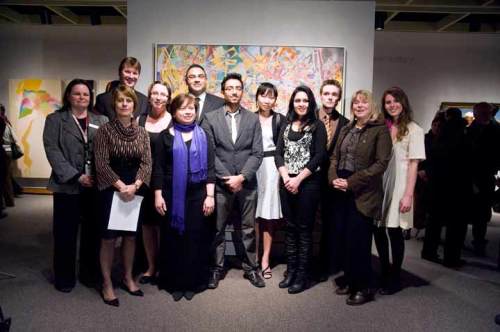The Art of Seeing

From left: Carol Podedworny, Joyce Zazulak, David Price, Erin Frotten, Maria Deleon-Matsuda, Lennox Mirander, Puneet Seth, Meng Lu, Faiza Upal, Andrew Smith, Karen Scott Booth, and Hannah Staniszkis (Jennifer Kagan not in photo). photo: Richard Zazulak
Last week we celebrated the opening of a new exhibition at the MMA – the final component of the McMaster Museum of Art/Family Medicine visual literacy collaboration. While the exhibition is a lovely example of the breadth and depth of the museum’s collection as well as an indication of the works in the collection which have triggered meaning for the medical residents, the goal of the The Art of Seeing program was much larger. The intent was not to produce doctors who could be curators but rather to produce doctors whose communication skills would be advanced such that they would be able to engage with their patients in more comprehensive ways.
Below is a quote from one of the residents which reveals, quite eloquently, the impact that The Art of Seeing has had on their development as Doctors of Family Medicine:
An art course like “The Art of Seeing Program” heightens our humanity, makes us more sensitive to, and understand the human situation more clearly, and opens our values to bring forth a steady flow of empathy and compassion, which naturally runs in our veins.
Art mirrors life.
We are confronted with a Goya painting depicting the horrors of war, and we see and feel the suffering, the agony and despair. We bring this heightened sense of “seeing” and “feeling” back into our own museums, where we have the privilege of encountering various precious works of art in the clinic, every single day. And we are able to better see and comprehend anguish and suffering in a cancer patient; or sheer frustration in a patient with cognitive impairment. We see the look of utter despair in the face of a young artist portrayed in the Great Depression, or the sad soulful eyes of a weathered and graying old lady in a lithograph, and the images are etched forever. And we can better see and feel despair and hopelessness in a suicidal patient, or in a marginalized immigrant patient who just feels so alone, isolated, and lost.
- Maria Deleon-Matsuda
Views: 324
Tags:
Welcome to
THE VISUAL TEACHING NETWORK
About
© 2025 Created by Timothy Gangwer.
Powered by
![]()
You need to be a member of THE VISUAL TEACHING NETWORK to add comments!
Join THE VISUAL TEACHING NETWORK